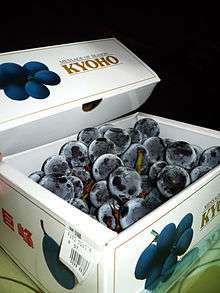Kyoho (grape)
| Kyoho | |
|---|---|
| Grape (Vitis) | |
 Kyoho-grape | |
| Color of berry skin | Black |
| Origin | Japan |
| Pedigree parent 1 | Ishiharawase |
| Pedigree parent 2 | Centennia |
| Notable regions | Nagano, Yamanashi, Japan |
| Breeder | Yasushi Ōinoue |
| Breeding institute | institute Ōinoue |
| Year of crossing | 1937 |
| Year of selection | 1942 |
| Year of protection | 1955 |
| Formation of seeds | Complete |
| Sex of flowers | Hermaphrodite |
Kyoho grapes (巨峰葡萄 Kyohō budō, literally "giant mountain grapes") are a Concord-like cross (Vitis vinifera × Vitis labrusca) between Ishiharawase and Centennial grape varieties. Like Concord, Kyoho is a slip-skin variety, meaning that the skin is easily separated from the fruit. Kyoho grapes are blackish-purple, or almost black, with large seeds. While the seeds are bitter and the skin is not traditionally eaten, the flesh is juicy with high sugar content and mild acidity.
Kyoho grapes were first produced in 1937 in Shizuoka Prefecture, but were not so named until 1946. They are popular in Japan, Taiwan, China, and Korea for their size and very sweet flesh. They are traditionally served peeled as a dessert, and the juice is used in making chūhai cocktails. Areas of production include Nagano Prefecture, Yamanashi Prefecture, California's Central Valley, Changhua County in Taiwan, and Chile.
As of 2015, Kyoho was the world's most cultivated grape variety by land area (365000ha). More than 90% of these vines are in China.[1]
References
- ↑ "Distribution of the world's grapevine varieties" (PDF). oiv.int. International Organisation of Vine and Wine. 28 February 2018. Retrieved 1 March 2018.